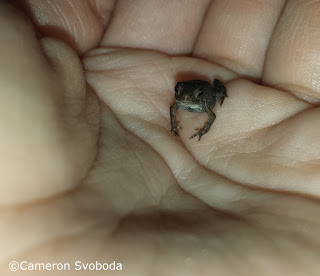 |
| A pea-sized toadlet sits perched on my thumb. |
For the past week, Blacklick Woods Metro Park has been hopping with teeny, tiny eastern American toads (Anaxyrus americanus americanus). These toads are common in Ohio from urban backyards to remote woodlands. In spring, they mate anywhere with shallow water, from ponds and ditches to tire ruts.
Males inflate their vocal sac and give a high trill that lasts 6 to 30 seconds. Their song is often mistaken for crickets chirping, but toads sing in the spring, while most crickets don't begin chirping until late summer.
One female American toad may lay as many as 12,000 eggs in long strands attached to aquatic plants, which hatch into tiny, jet-black tadpoles. The tadpoles steadily grow by eating algae and aquatic vegetation for over a month. Then, by early June, they emerge from the water as pea-sized toads.
American toads are extremely beneficial to people, especially in gardens, eating huge numbers of invertebrate pests like insects and slugs. The U.S. Department of Agriculture estimates that a single adult toad can eat almost 10,000 insect pests over the course of an average summer.
Toads do not have warts, and people do not get warts from handling toads. The bumps on a toad's skin are actually glands that secrete bufotoxin, a poison that burns the sensitive mouth tissues of predators. Unless it gets in the eyes or mouth, it is harmless to humans.
Despite this defensive measure, mortality for the juvenile toads is high, else there would not need to be so many of them. At this size, even an insect or spider could make a meal out of a poor little toad! But, as with the snapping turtles mentioned in my previous post, enough manage to bring their own teeny, tiny offspring into the world to continue their species' survival.


No comments:
Post a Comment